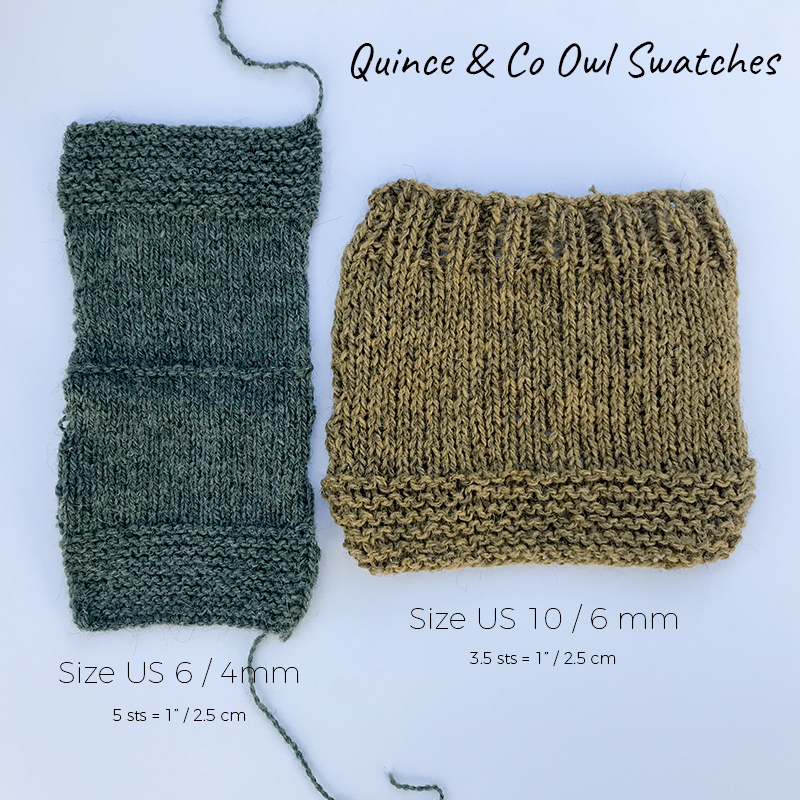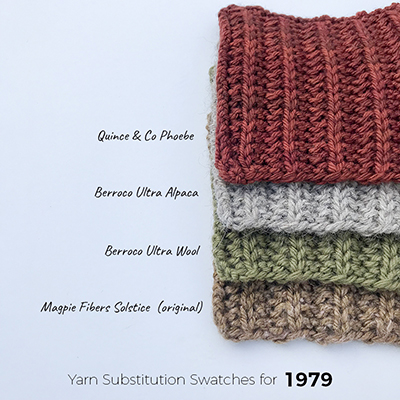My latest design, 1979, calls for heavy DK or light-worsted weight yarn. But what exactly does that mean? Well, yarn is classified into different weights (fingering, sport, dk, worsted, etc) depending on how thin or thick the strand of yarn is. And then within each of these weight classifications, yarn will range from being on the thin side of that classification to the thick side. So if a yarn is a heavy-DK weight, it will often knit up quite similarly to a light-worsted weight. The proof is in the pudding as they say, so check out these swatches, all worked in the stitch pattern for 1979:

The bottom swatch uses the original yarn I used for the pattern – Magpie Fibers Solstice, listed as a DK. The green swatch is Berroco Ultra Wool, listed as a Worsted, the gray swatch is Berroco Ultra Alpaca, also listed as a Worsted, and the top red swatch is Quince & Co Phoebe, listed as a DK. So 4 different yarns, 2 different classifications, but I got the same exact gauge for all 4 using a US 8/5 mm needle. They each have their own unique fabric and feel, but all 4 are great yarn options for 1979.

Gauge & Swatches
Just because I got gauge on a US 8/5 mm needle does not necessarily mean you will! Everyone’s tension can be different, so the key is to swatch swatch swatch. And swatching will also tell you whether or not you like how the fabric looks at a certain gauge. A yarn can do just about anything you want it to, but you may not be happy with the fabric created. For example, you can take a skinny sport-weight yarn and “make it” get a heavy-worsted weight gauge of 4 sts = 1″/2.5 cm by knitting it on a much larger-than-recommended needle size for that yarn, but will you like the fabric it creates? It will be very loosey goosey – great maybe for a summer, drapey tee but not great if you want a structured fall cardigan. The below photo shows 2 different swatches I had in my stash of Quince & Co Owl – different colors and amount of stitches, but you can see the fabric difference between the two. The leftside swatch is done on a US 6/4 mm (getting a gauge of 5 sts = 1″/2.5 cm) and the rightside swatch is done on a US 10/6 mm (getting a gauge of 3.5 sts = 1″/2.5 cm). Same yarn, different needles, different gauge and very different fabric:

When in doubt, talk to the staff at your local yarn shop – they know the yarns they carry best and can help you navigate all your potential options. Also, many designers are more than happy to help suggest yarns or at least give their opinion on whether or not a yarn you are thinking about will work for the pattern. And of course, Ravelry is a great resource. When you are looking at a particular pattern, click on the “Yarn Ideas” tab at the top and it will tell you what yarns other knitters have used for that particular pattern. This doesn’t take the place of swatching, but it can help guide you on picking a good yarn option.
Happy swatching!

